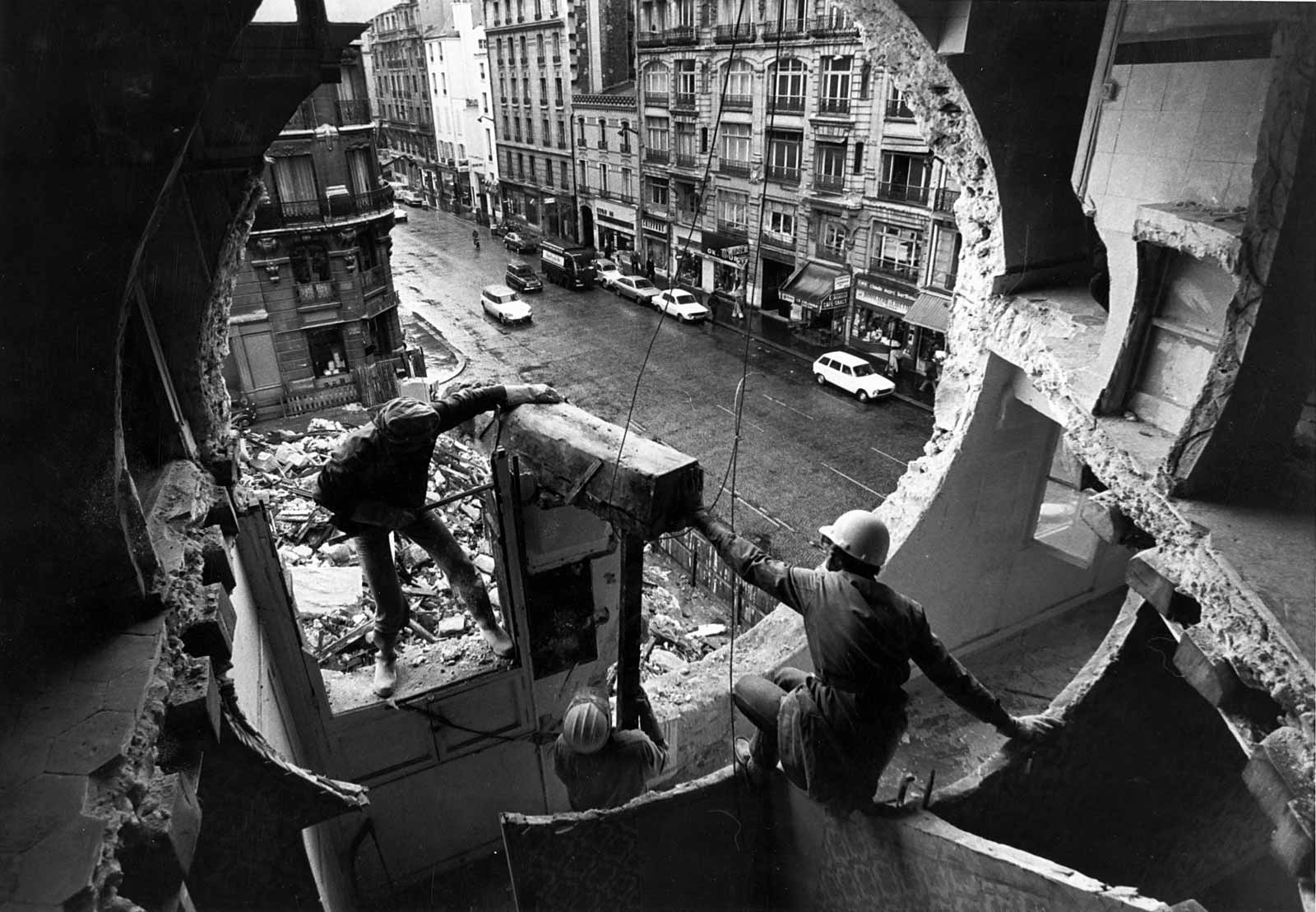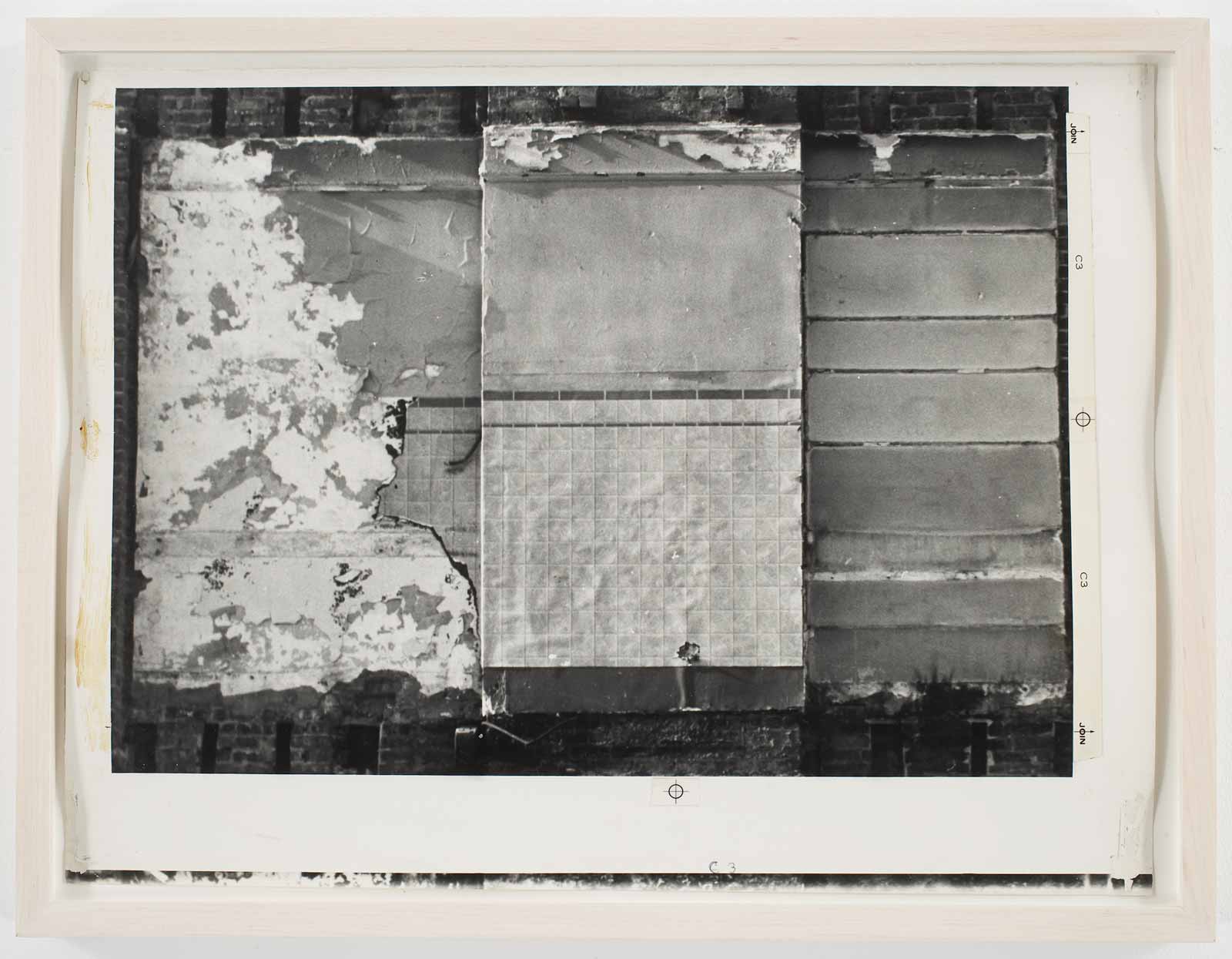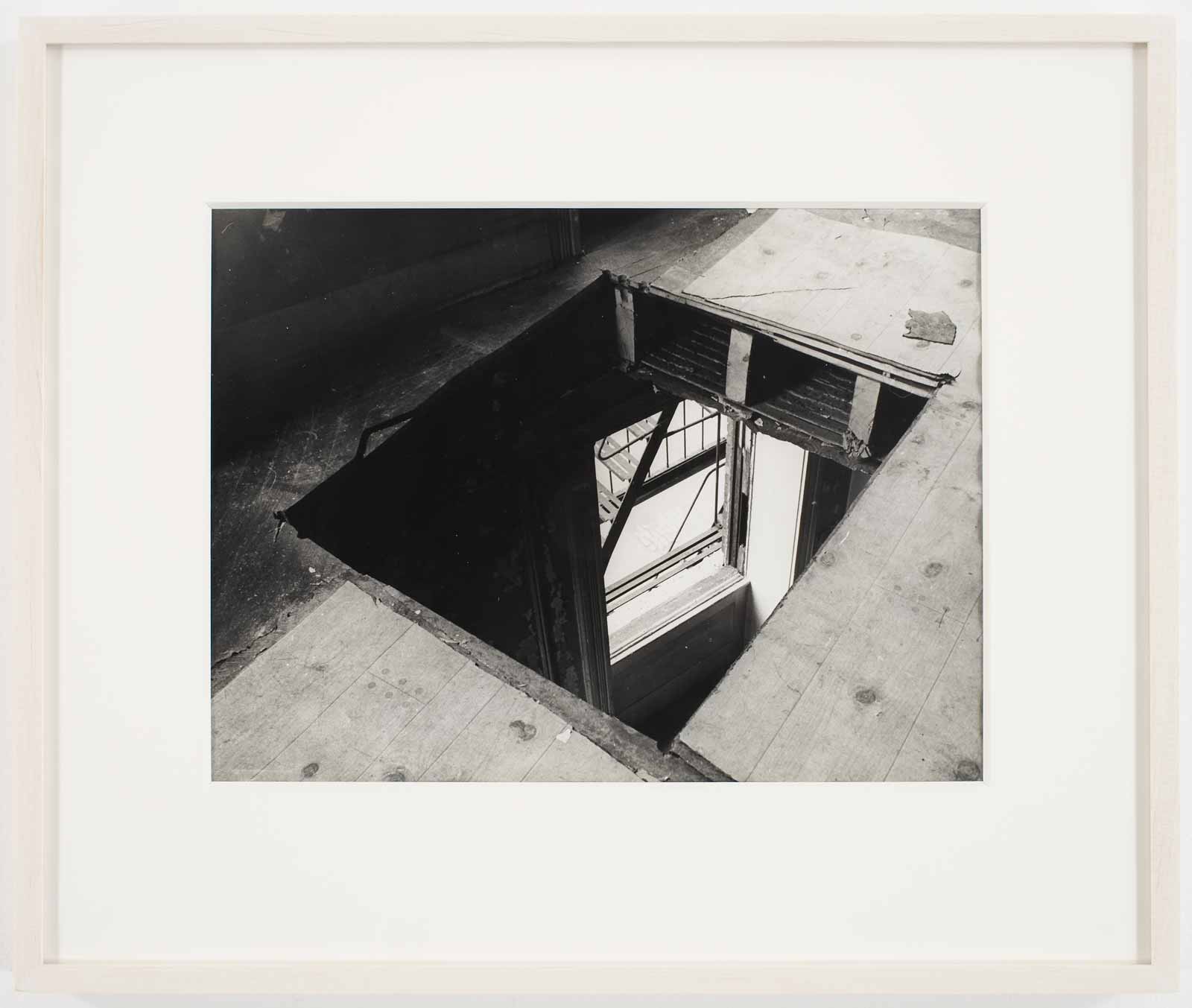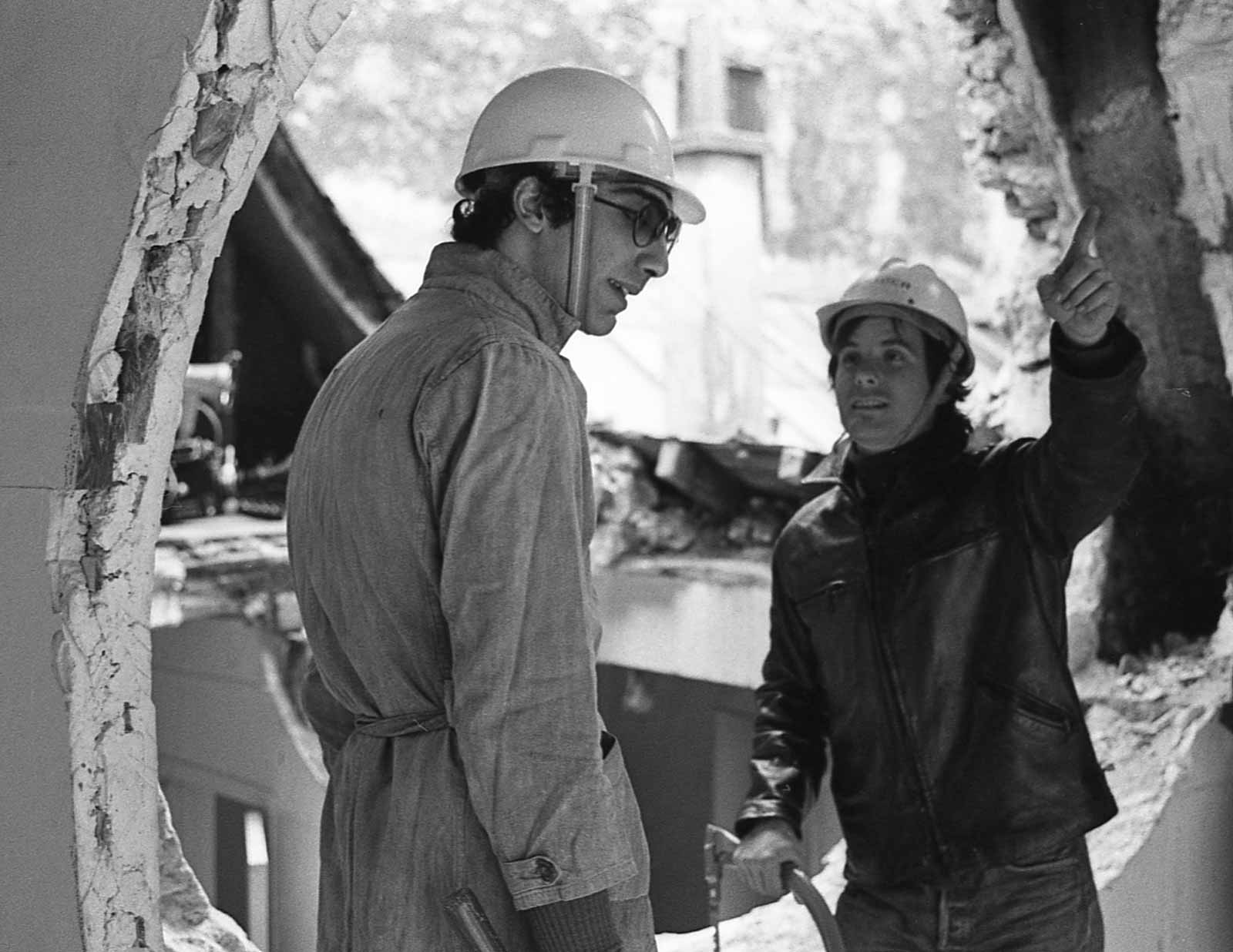Gordon Matta-Clark was the James Dean of postwar American art. Like Dean, he was a charismatic rebel who upended conventional notions about his craft, inspired countless younger artists, died at an early age, and left cult-like legions of fans who mourn his loss to this day. Matta-Clark’s audacious hybridization and redefinition of three mediums—architecture, sculpture, and painting—opened new modes of contemporary expression just as decisively as the maverick actor had done.
Much in the same way that Dean’s subversive remake of Hollywood stardom during the mid-1950s drew on his deepest psychological conflicts, two decades later Matta-Clark cut through derelict buildings with chainsaws to reveal their long-hidden interiors. He likewise saw the spray-painted graffiti that were appearing all over New York City not as vandalism but as a means for common people to reclaim their civic identity, and his arresting super-long photos of “tagged” subway cars presented them as a new kind of kinetic pop sculpture. This interest anticipated by several years the emergence of artists including Keith Haring and Jean-Michel Basquiat, who began as outlaw taggers but became stars of the 1980s art scene after being discovered by savvy dealers, as well as Charlie Ahearn’s 1983 film Wild Style, the first cinematic treatment of the downtown graffiti and hip-hop culture. In all, Matta-Clark sought to expose the failures of a rich but misdirected society that during the Vietnam War let its public responsibilities erode, which gave his seemingly destructive approach a sharply political edge.
Many reasons for this master troublemaker’s continuing grip on the artistic imagination are evident in the Bronx Museum of Art’s exhibition “Gordon Matta-Clark: Anarchitect,” which takes its subtitle from the subject’s own coinage for his contrarian occupation. Insightfully organized by the museum’s curatorial director, Antonio Sergio Bessa, and Jessamyn Fiore, co-director of the Matta-Clark Estate (along with her mother, Jane Crawford, the artist’s widow), the retrospective fully conveys the conceptual grandeur and raw physicality of Matta-Clark’s art, despite the fact that his most famous site-specific works no longer exist. Termed “building cuts,” those projects can only be revisited through photographs, videos, drawings, and fragmentary details, all of which are on view here.
By partially dismantling large-scale structures to make something entirely new, Matta-Clark defined an urban equivalent of Land Art, the massive earthwork installations created in remote settings during the 1960s and 1970s by Michael Heizer, Walter de Maria, Richard Long, and, above all, Robert Smithson, best remembered for his Spiral Jetty in Utah’s Great Salt Lake. (Smithson, who hired Matta-Clark as an installation assistant for the Cornell University art museum’s landmark 1969 “Earth Art” exhibition, was killed in a plane crash while scouting sites for an earthwork in Texas at thirty-five, the same age at which his protégé would die.)
Never was Matta-Clark’s genius more dramatically demonstrated than in Day’s End (1975), his unsanctioned appropriation of Manhattan’s abandoned Pier 52 on the Hudson River, which he stealthily turned into what he called a “sun-and-water temple.” This he accomplished by burn-cutting through the corrugated metal walls of the vast, disused maritime cargo terminal to create a series of painstakingly plotted, curved openings through which sunlight would stream to form veritable sculptures that had a cosmic aura that, doubtless, would have impressed the druids of Stonehenge.
The exhibition’s close proximity to the sites of some of the artist’s most important deconstructions in the South Bronx, epicenter of the urban squalor that accompanied the city’s 1970s fiscal crisis, adds particular immediacy to this survey. One highlight is Bronx Floors (1972–1973), a nearly four-foot-square chunk of wood, linoleum, and patterned dark-blue wallpaper preserved from one of his apartment-house demolition derbies, and later given to the Museum of Modern Art by the former husband of Matta-Clark’s first dealer, the risk-taking SoHo gallerist Holly Solomon.
Matta-Clark was a son of the Chilean Surrealist artist Roberto Matta and the American painter Anne Clark. Matta had studied architecture and worked as a draftsman in the Paris atelier of Le Corbusier from 1935 to 1937. Even if one resists the temptations of psychobiography, it is difficult not to see an oedipal element in Matta-Clark’s vocational path. A few months after Gordon and his twin brother, Sebastian, were born in New York in 1943, Matta abandoned his wife and sons, who thereafter led what has blandly been called a peripatetic existence until, five years later, Clark remarried and resettled in Manhattan, with the film critic Hollis Alpert. Despite evidence to the contrary, Matta insisted that he barely saw his sons while they were growing up; in any event, it cannot have been a happy relationship. (Sebastian committed suicide in 1976 when he jumped from a window in Gordon’s SoHo loft studio.)
Advertisement
Matta-Clark studied architecture at Cornell, where he received his degree during the cataclysmic spring of 1968 and promptly rejected routine applications of what he’d learned there. He was especially disdainful of his father’s erstwhile employer, despite Le Corbusier being the twentieth century’s most influential master-builder. In a 1973 letter about a proposed “Anarchitecture” exhibition, he turned one of Le Corbusier’s catchphrases on its head by suggesting that the show include “AN [sic] MACHINE FOR NOT LIVING IN WITH AN EXTRACT FROM CORBUSIER’S VERSO UN ARCHITEC [Vers une architecture] SHOWING THE VIRGIN MACHINE HE WANTS US ALL TO LIVE IN.” Although there was already a nascent revolt among Postmodernist architects who opposed Le Corbusier’s mechanistic aesthetic, Matta-Clark’s family history gave his contempt a more personal edge.
Within a very few years, he single-handedly established a new genre of environmental art, in which he used abandoned buildings as raw material and radically transformed them into stunning found sculptures. A prime example was Splitting: Four Corners (1974), in which he took an unoccupied wood-frame house in Englewood, New Jersey, and made a two-story-high vertical incision from the roof to its raised masonry foundation, which caused the rear half to lean back slightly, although the whole did not collapse.
Despite distancing himself from the architectural mainstream, Matta-Clark kept an eye on what the leading avant-garde figures were up to, including Louis Kahn, whose concept of “wrapping ruins around buildings” was echoed by the artist. Clearly, the gigantic oculi that Kahn employed in contemporaneous buildings such as his Philips Exeter Academy Library of 1965–1972 in Exeter, New Hampshire, must have been known to the anarchitect, who made similar voids in several of his deconstructions.
Matta-Clark’s Conical Intersect of 1974 in Paris aligned two circles of different sizes that he cut into parallel walls of a building being torn down next to the new Pompidou Center’s construction site. Those paired Kahnian apertures defined a cone-like volume of light that seemed to hover in mid-air while the half-wrecked relic briefly stood. This widely-publicized project resonated among experimental-minded architects, most notably Frank Gehry, who has often cited the huge impact that Matta-Clark’s work had on his own sense of how beautiful a building could be if its structural components were not concealed.
By any reckoning, Matta-Clark’s career was meteoric: it lasted barely a decade, until his death from pancreatic cancer in 1978. Yet for all the weightiness that surrounds the issues Matta-Clark addressed—power and poverty, permanence and decay, monumentality and intimacy—there remains a surprising lightness of spirit to his legacy, and a reckless élan still inhabits what we know, even second-hand, of his work.
In addition to their innovative artistry, James Dean and Gordon Matta-Clark were alike physically—slightly built, boyishly handsome, and mercurial in motion—which has further enhanced their mystique as doomed demigods. In a 2008 interview, Jane Crawford touched on this with a wistful memory of her first husband: “A lot of people have noticed that Gordon was a great dancer.… I would say that gravity didn’t affect him like it affects the rest of the world.… He danced through his whole life in some way.”
“Gordon Matta-Clark: Anarchitect” is at the Bronx Museum of the Arts through April 8, 2018, after which it will travel to the Jeu de Paume in Paris; the Kumu Art Museum in Tallinn, Estonia; and the Rose Art Museum at Brandeis University in Waltham, Massachusetts. Gordon Matta-Clark: Anarchitect, by Antonio Sergio Bessa and Jessamyn Fiore, is published by Yale University Press.







